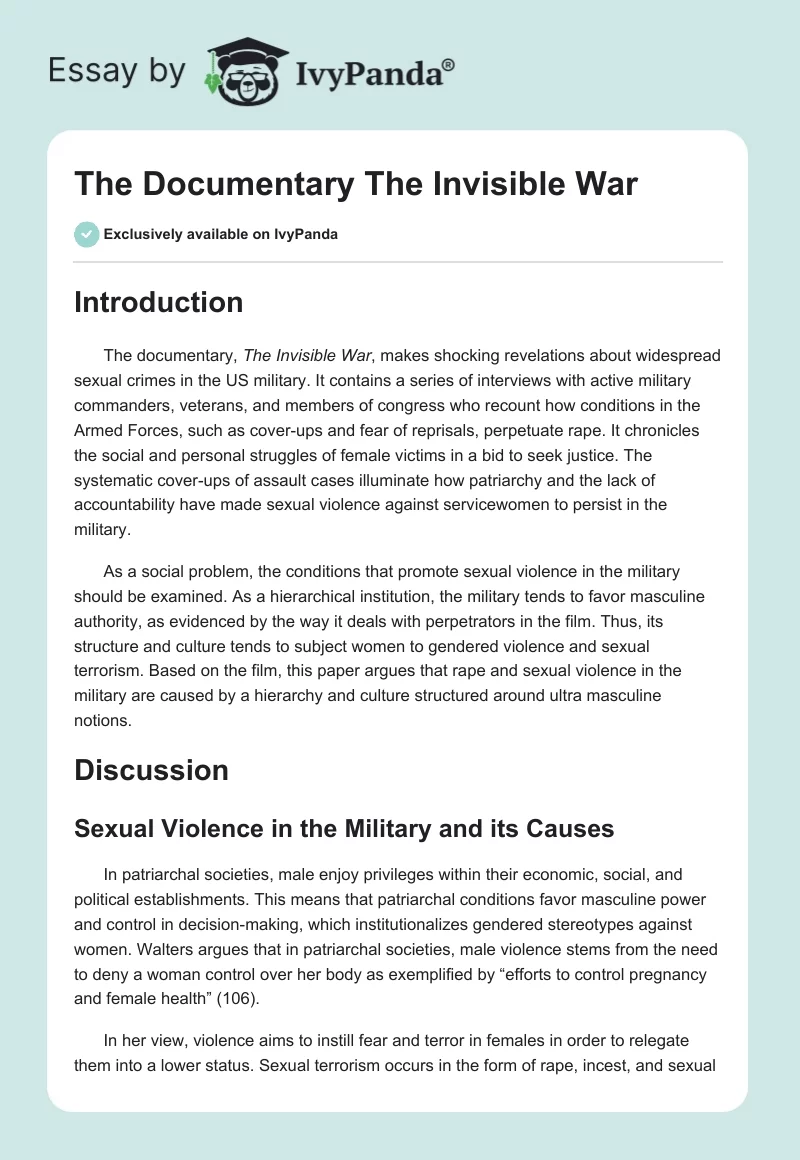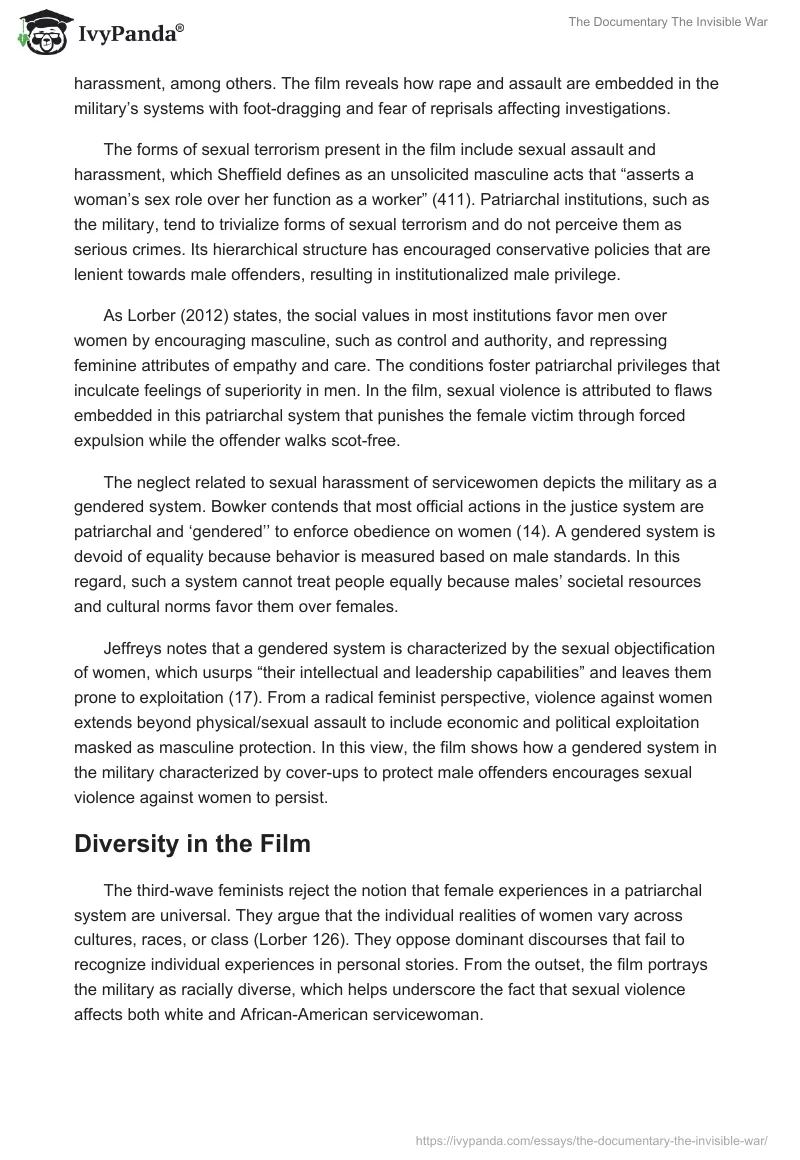Introduction
The documentary, The Invisible War, makes shocking revelations about widespread sexual crimes in the US military. It contains a series of interviews with active military commanders, veterans, and members of congress who recount how conditions in the Armed Forces, such as cover-ups and fear of reprisals, perpetuate rape. It chronicles the social and personal struggles of female victims in a bid to seek justice. The systematic cover-ups of assault cases illuminate how patriarchy and the lack of accountability have made sexual violence against servicewomen to persist in the military.
As a social problem, the conditions that promote sexual violence in the military should be examined. As a hierarchical institution, the military tends to favor masculine authority, as evidenced by the way it deals with perpetrators in the film. Thus, its structure and culture tends to subject women to gendered violence and sexual terrorism. Based on the film, this paper argues that rape and sexual violence in the military are caused by a hierarchy and culture structured around ultra masculine notions.
Discussion
Sexual Violence in the Military and its Causes
In patriarchal societies, male enjoy privileges within their economic, social, and political establishments. This means that patriarchal conditions favor masculine power and control in decision-making, which institutionalizes gendered stereotypes against women. Walters argues that in patriarchal societies, male violence stems from the need to deny a woman control over her body as exemplified by “efforts to control pregnancy and female health” (106).
In her view, violence aims to instill fear and terror in females in order to relegate them into a lower status. Sexual terrorism occurs in the form of rape, incest, and sexual harassment, among others. The film reveals how rape and assault are embedded in the military’s systems with foot-dragging and fear of reprisals affecting investigations.
The forms of sexual terrorism present in the film include sexual assault and harassment, which Sheffield defines as an unsolicited masculine acts that “asserts a woman’s sex role over her function as a worker” (411). Patriarchal institutions, such as the military, tend to trivialize forms of sexual terrorism and do not perceive them as serious crimes. Its hierarchical structure has encouraged conservative policies that are lenient towards male offenders, resulting in institutionalized male privilege.
As Lorber (2012) states, the social values in most institutions favor men over women by encouraging masculine, such as control and authority, and repressing feminine attributes of empathy and care. The conditions foster patriarchal privileges that inculcate feelings of superiority in men. In the film, sexual violence is attributed to flaws embedded in this patriarchal system that punishes the female victim through forced expulsion while the offender walks scot-free.
The neglect related to sexual harassment of servicewomen depicts the military as a gendered system. Bowker contends that most official actions in the justice system are patriarchal and ‘gendered’’ to enforce obedience on women (14). A gendered system is devoid of equality because behavior is measured based on male standards. In this regard, such a system cannot treat people equally because males’ societal resources and cultural norms favor them over females.
Jeffreys notes that a gendered system is characterized by the sexual objectification of women, which usurps “their intellectual and leadership capabilities” and leaves them prone to exploitation (17). From a radical feminist perspective, violence against women extends beyond physical/sexual assault to include economic and political exploitation masked as masculine protection. In this view, the film shows how a gendered system in the military characterized by cover-ups to protect male offenders encourages sexual violence against women to persist.
Diversity in the Film
The third-wave feminists reject the notion that female experiences in a patriarchal system are universal. They argue that the individual realities of women vary across cultures, races, or class (Lorber 126). They oppose dominant discourses that fail to recognize individual experiences in personal stories. From the outset, the film portrays the military as racially diverse, which helps underscore the fact that sexual violence affects both white and African-American servicewoman.
The film estimates that one in every five servicewomen has been sexually assaulted in service with over 22,000 cases of sexual violence occurring in 2012. The sheer magnitude of sex crimes in the forces can make radical feminists to conclude that the experiences are shared among female victims. However, since about a third of servicewomen are women of color compared to black men (16%), their proportion is significant in military (Bowker 44). Thus, both black and white women need protection from sex violence perpetrators.
In the film, the stories of the women rape victims resonate well with the notions of the third-wave feminism. One survivor, Trina McDonald, reveals how she was sexually assaulted at an Alaskan naval station after being given a drug that made her unconscious. On her part, Elle Helmer, recounts how her colleagues at a Washington Marine station harassed and raped her. Another victim, Kori Cioca, narrates how a commander raped her when serving as an officer in the Coast Guard.
In all the three cases, the perpetrators were never prosecuted indicating a deep-rooted culture of impunity in the military. The commanders dismissed the charges, dragged their feet, or charged a few offenders and the victims as well. The filmmakers assumed a third-waver approach to tell the unique message behind each story. However, the film does not highlight the plight of female victims across the races. As such, the effect of race on sexual violence is a bit obscure.
Sexual Assault as a Product of a ‘Masculinized’ Culture
Globally, war involves different forms of violence against civilians and female soldiers. Active service members perpetrate violence in a sexualized manner against their opponents and sometimes civilians. Jeffreys attributes this form violence to the fact that the notion of aggressive masculinity notions that form the foundation of militaries and warfare. The film frames sexual assault in the context of militaristic culture that tends to be more masculine than feminine.
Besides military women, females residing near naval bases or enemy territory are also prone to sexual violence due to the masculine culture. Feminist critics contend that the military needs an aggressive masculinity to run. However, Jeffreys notes that the military perpetuates sexual harassment (through foot-dragging and inaction) to “protect the gendered nature of the institution” (19). Even among civilians, a culture of gendered female role persists due to sexualized masculinity.
The stories told in the Invisible War relate strongly to sexual terrorism crimes. According to Sheffield, sexual crimes against women bear six common characteristics: “they cut across socioeconomic lines, are less likely to be reported, when filed, they do not lead to conviction, are blamed on the victim, are rarely taken seriously, and involve male dominance” (414). The perpetrators belong to different age groups, ranks, races, and economic classes. The victims’ stories in the film show that the offenders were different ranks and included a Coast Guard commander, sailors, and marines. Thus, there is no typical perpetrator in the military; rather, any male officer is a potential offender. This shows that sexual harassment transcends all socioeconomic lines, and thus has its roots in the military or the US culture.
Sexual terrorism is also characterized by underreporting of sex crimes. According to Sheffield, as much as 90 percent of rape cases go unreported despite the high prevalence of sexual crimes (416). Most rapes, wife beating, incest, and child abuse cases involving fathers as the perpetrators go unreported in the US. Among the reasons for underreporting of sex crimes, include the accepted sexual innuendos and the trivialized nature of the harassment.
These behaviors are characteristic of patriarchal societies that treat female as sexual objects to satisfy their own needs. In the film, the commanders dismissed sexual abuse cases while most victims failed to file such crimes. In addition, the bureaucratic systems in the military delay the processing of filed cases with only a few offenders being committed to adultery charges, instead of rape. Sometimes, the survivors are prosecuted along with the offenders. These factors contribute to the high rate of underreporting of sex crimes.
Sexual violence against women also involves fewer convictions due to gendered female roles and traits. Due to gender socialization, men associate passivity and silence with the feminine. In addition, male sexual behavior is attributed to female actions or roles. According to Sheffield, the intention of these beliefs and attitudes is to silence women from contesting their victimization because they fear that no one will believe or trust them. In this view, most offenders go scot-free after committing rape or sexual harassment.
Kitfield estimates that the probability of a sexual assault case resulting in a conviction of the offender is less than five percent (69). In particular, fewer convictions are likely to occur if the victim knows the perpetrator or if the offender occupies an influential place in the society. In the film, despite allegations of rape being filed against them, no action was taken against the commanders involved in sexual abuse. A culture of self-protection in the military has derailed the conviction of offenders.
The fear of reprisals also prevents victims from reporting assault cases to the authorities. The film illustrates how a culture of impunity has led to pervasive sexual assault in the military. The system “condones the male offender and victimizes the female victim” for encouraging the abuse (Sheffield 419). As the film reveals, female victims often end up being convicted of adultery charges, though they suffered violent sexual crimes. The victimization is a product of socialized gender attitudes and beliefs in the military culture.
Conclusion
The Invisible War brings to the fore the issue of sexual violence in the military. The interviews involving the victims, the military commanders, and lawmakers show that sexual abuse is pervasive, largely because of patriarchal and bureaucratic systems in the military. The military is built around notions of masculine aggression, which trivializes sexual innuendos and victimizes females. This approach creates gendered attitudes and beliefs that prevent reporting of sex crimes against women.
Works Cited
Bowker, Lee. Masculinities and violence. Thousand Oaks, CA: Sage Publications, 1998. Print.
Jeffreys, Sheila. Double jeopardy: Women, the US military and the war in Iraq. Women’s Studies International Forum 30 (2007): 16–25. Print.
Kitfield, James. The Enemy within Defense. National Journal 15 (2012): 67-81. Print.
Lorber, Judith. Gender Inequality: Feminist Theories and Politics. Oxford: Oxford University Press, 2012. Print.
Sheffield, Carole. “Sexual Terrorism”. Women: A feminist Perspective. Ed. Freeman Jo. Houston, TX: Mayfield Publishing Co., 1995. 411-421. Print.
Walters, Margret. Feminism. A very Short Introduction. Oxford: Oxford University Press, 2005. Print.


